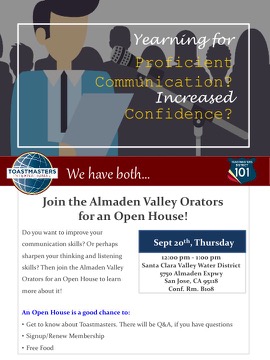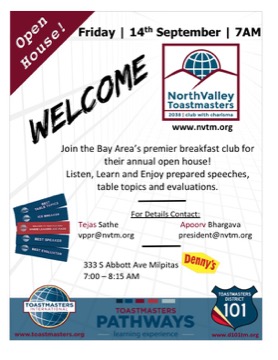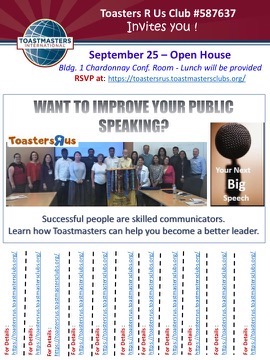PR Tools and Tips for Clubs
Explore the many resources available to your club.
In most circumstances, the best PR resource for any club is its members. Your club’s members know your club, understand what appeals to them about your club, and can readily speak about the benefits of Toastmasters and their own personal experience.
With that being said, there are a variety of tools available to help clubs with their PR efforts. Listed below are several tools, tips, and techniques to inform and promote your club, engage members, and attract guests (i.e. prospective members).
Click on one of the buttons below to jump to that section on this page.
Aside from word-of-mouth, having a club website is critical for the promotion of your club. A website is at the very heart of your club’s online presence, and it’s one of the first items that appears when people search for a club on the Toastmasters International website and on the District 101 website.
Maintaining an up-to-date website is key to attracting guests and new members, because it provides important information about your club: when it meets, how to attend a meeting, and how to contact your club. Your website can also share a sneak peek into your club’s personality, with photos of club members in action, member profiles, and news about recent activities like club contests and workshops.
Setting Up Your Website
Fortunately, you don’t need to start from scratch. There are website platforms that have been designed specifically for Toastmasters clubs, often featuring a wide range of capabilities for managing and promoting your club — such as scheduling meetings, agenda planning, tracking educational activities, displaying club officer contact information, and managing member distribution lists. These online tools make setting up and maintaining a website easy.
Here are a few of the most popular services for managing a Toastmasters club website:
- FreeToastHost: This is the primary platform promoted by Toastmasters International. Your club can request a website at https://www.toastmastersclubs.org/welcome/.
- Easy-Speak: This online tool has also been developed specifically for Toastmasters clubs’ needs to automate their meeting planning and track and support members’ educational development.
- Toastmost: This is the most recent service, built on the WordPress for Toastmasters platform. In addition to club management, Toastmost provides additional capabilities such as online timers, contest tools, blogs, and video sharing.
Alternatively, there are several other platforms (not specifically designed for Toastmasters) that can be used for a club website, but they may require additional technical skills.
- MeetUp: A club may use MeetUp as its only website. A Meetup page helps promote your club’s meetings to a wider audience and provides RSVP capabilities, as well as discussions and reviews.
- Hosted website: Some clubs have chosen to build their own custom websites. There are several advantages and disadvantages to this approach:
- By building your own club website, you can make it look exactly the way you want, with its own customized website address (URL).
- Building the site will require extra effort and/or technical skills to get everything up and running. Some hosts provide templates and other services to simplify this process.
- This approach typically involves additional fees (for hosting services, domain name registration, etc.).
- Some providers offer services to build a site for you, for a fee.
- There are several hosting platforms to choose from, including GoDaddy, Wix, Squarespace, web.com, and many others.
- Blog sites: Clubs can use a blogging platform to enhance its online presence. There are several hosting platforms to choose from, including WordPress.com, Wix, Blogger, Tumblr, and many others.
- Social media pages: Some social media sites (such as Facebook and LinkedIn) can provide landing pages for your club. Please refer to the Social Media section below for more details.
Club Website Tips
- Keep management simple. Your club’s website should be easy to maintain (i.e. require NO programming skills) so that new members taking on new roles can manage your site into the future.
- Remember to always ask for a non-profit discount for any Toastmasters business.
Club newsletter can serve two important roles:
- Provide Information. A newsletter is a great way to keep club members, potential members, and guests informed of upcoming and recent activities, member highlights and testimonials, messages from club officers, member contributions, and promotions from District 101.
- Promote Your Club. Clubs can share and distribute their newsletters as a take-away for guests and potential members. Sharing photographs* of members, club events, and contests helps readers get to know your club and observe members enjoying club activities. (*Remember to obtain permission for use of photographs.)
Creating Your Newsletter
Here are a number of popular tools for creating a club newsletter:
- Email and marketing services. Sites include Constant Contact, Hubspot, Mailchimp, and Vertical Response.
- Online and app design apps. Tools include Canva, as well as several smartphone apps.
- Design and publishing apps, including Adobe Illustrator and InDesign, Apple Pages, and Microsoft Publisher.
- Toastmasters International template. As a starting point, TI provides a downloadable template that’s available for use by all clubs. Alternatively, if you’d like to create a newsletter from scratch, TI also provides several official Toastmasters graphics and other assets.
Tip: Toastmasters International recommends using the official color palette, found on Page 12 of the TI Brand Manual, on all promotional material.
Distributing Your Newsletter
Electronic distribution has become the most common method of distribution, especially during the pandemic. Some tools are better suited for HTML newsletters, which can be placed on websites and sent via email. Others are better suited for creating PDFs and JPGs, which can be placed on a website and/or printed as hand-outs for members and guests.
An active social media presence will bring attention to your club and immediately increase your guest attendance. Social media channels provide a quick and easy — and free — way to highlight your club, promote upcoming events, and showcase the achievements of your fellow members.
District 101 uses multiple social media channels, and you are encouraged to follow them.
Recommended Plan of Action
- Choose 2-3 channels. Having a solid focus is key. Don’t try to dive into all social media channels at once. Begin with a website, and with 1-2 social media channels before expanding. Determine where your club is most likely to engage its target audience. For example, if your members and potential members don’t use Twitter, you may want to prioritize other channels.
- Engage your members. Regardless of the platform(s) you choose, have club members engage by liking, sharing, and commenting on posts.
- Post regularly. Most social media platforms have algorithms that prioritize posts with high engagement, and for accounts that post frequently.
- Measure your results. Nearly all social media sites allow you to gauge your campaign’s effectiveness with analytics (user engagement, click-throughs, etc.). Over time, these tools will help you determine the most effective way(s) to reach your target audience.
Available Options
Here are some of the most popular social media platforms:
- Meetup : Clubs can sponsor their own MeetUp accounts, which are sometimes used in lieu of other types of website platforms.
- Your club may want to leverage District 101’s Meetup page. Sponsored by D101, this page is available for all clubs in the district to use to publicize meetings and events.
- Facebook: Clubs can set up their own Facebook pages. avoid using a personal account as the club identity. Use pages, which are public, for posts and events; for communication between members, you can also leverage groups.
- Instagram: Sharing images is the backbone of Instagram. Photos and videos can be linked to a Facebook page. Links are only available in the account bio, not within individual posts.
- YouTube: Clubs can create a club-specific channel on YouTube and upload videos for either private access (club members only) or public viewing.
- LinkedIn: Because the many skills that Toastmasters learn can have a huge impact on professional careers, leveraging a career-focused social network like LinkedIn makes perfect sense — both for promoting your club and for highlighting member achievements.
- Twitter: Twitter can be a very effective way to reach a large audience in minutes, with quick-hit updates, posts, and links for upcoming activities.
Professional Review Sites
Some clubs use business review sites, where posts can be uploaded in specific categories (e.g. events, for sale, etc.). Most of these sites use location services to determine the results that are shown. Most also feature reviews of particular businesses and organizations (in our case, clubs). These reviews cannot be easily removed, so they should be used with caution. Avoid regular/multiple posts of members for these sites, as misclassified posts will be removed.
Here are a few of the most common business review sites:
Automation
There are a number of automation tools that make is easy to upload posts to multiple platforms at once and schedule posts over a period of time. These tools include Sprinklr, Buffer, Hootsuite, and Zapier.
Check out the District 101 Social Media Tips for more information on how to effectively use various social media platforms to promote your club.
Sharing videos is an increasingly popular way for clubs to engage with members and prospective members — and videos provide a tremendous creative outlet for displaying your club members’ talents. They can be used for multiple purposes: promoting your club, sharing member testimonials, providing speaking tips, guiding members about meeting roles, discussing how to navigate Pathways, etc. Some clubs record their meetings so that speakers can use these videos for self-evaluation. The possibilities are virtually endless.
Recording Tools
- Smartphone videos
- Zoom recordings
Editing Tools
- Smartphone apps
- PC and Mac
- Camtasia (by Techsmith)
- Filmora (by Wondershare)
- Premiere Rush (by Adobe)
- Mac
While many communication channels have been moving to an online format in recent years, particularly during the pandemic, there may still be several times when printed materials are an effective way to promote your club and its activities.
Club Flyers
When it comes to organizing a special event like an open house or workshop, the success of the event often relies heavily on your ability to make sure that people are aware that it’s happening.
Whether in a digital or printed format, flyers provide a effective way to advertise your event. Flyers can be used on your website, in social media, and for members to send to friends and colleagues. As physical locations begin to re-open after the pandemic, posting and distributing flyers will once again become a helpful way to promote your event.
There are a number of popular tools for creating an event flyer:
- Design and publishing apps, including Adobe InDesign and Illustrator, Apple iPages and Keynote, Microsoft PowerPoint and Word.
- Online and app design apps. Tools include Canva, as well as several smartphone apps.
- Flyer template from Toastmasters International. As a starting point, TI provides several downloadable templates that are available for use by all clubs. Alternatively, if you’d like to create a flyer from scratch, TI also provides several official Toastmasters graphics and other assets.
- For ideas about creating an event flyer for your club, check out some of the sample flyers from District 101 clubs, including some that have won district awards.
Here are a few samples of open house flyers from District 101 clubs. Click on any of them to see the full-sized flyer.
Club Business Cards
Having your own Toastmasters business card can help you make a lasting impression at your next club meeting, open house, or other event. The business card should include your club name, meeting information, website, and/or your email address. Providing this information on a card makes it easy for your guests to get in touch with your club — and remember you. Business cards are more likely to be saved than flyers, simply because cards are smaller and easier to slip in a pocket.
- To get started, download one of the business card templates from Toastmasters International.
- Print them on a printer, or use online services (such as FedEx, moo, or VistaPrint) or one of your local printers.
Brochures
Brochures typically have a longer life span than an event-specific flyer. They can provide additional details about your club and/or about Toastmasters, and because they typically have more space to contain information, they can more successfully highlight your club’s personality.
- Designing your own club brochure. The design tools noted above can be used just as effectively to create a club brochure as an event flyer.
- Toastmasters International brochures. TI provides a number of brochures that clubs can use to promote the Toastmasters organization as a whole. Some of these brochures have been made available at no charge to members, and they can be ordered from the TI online store.



